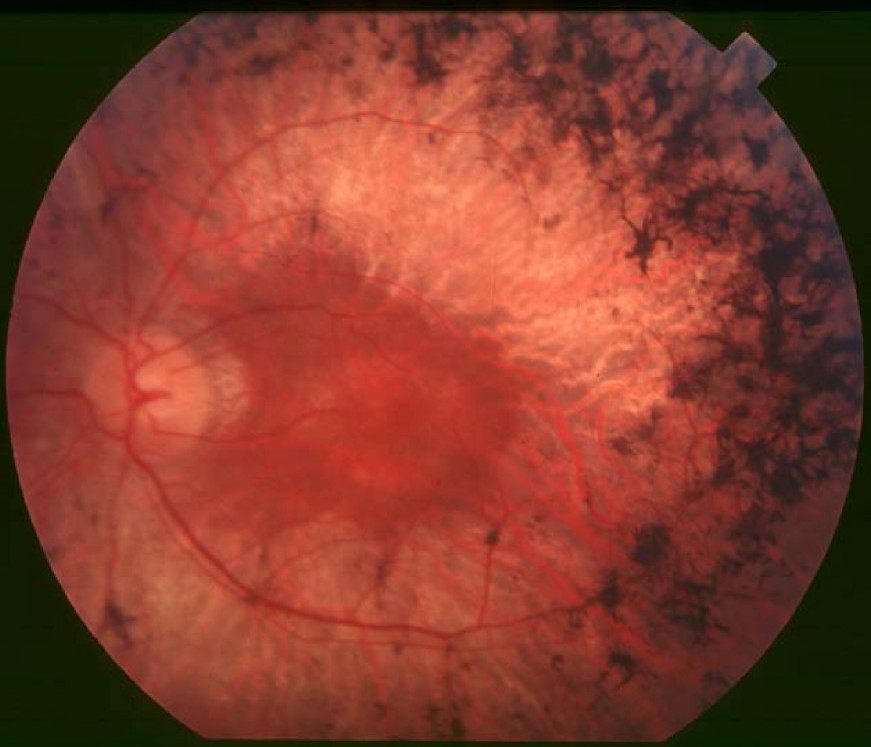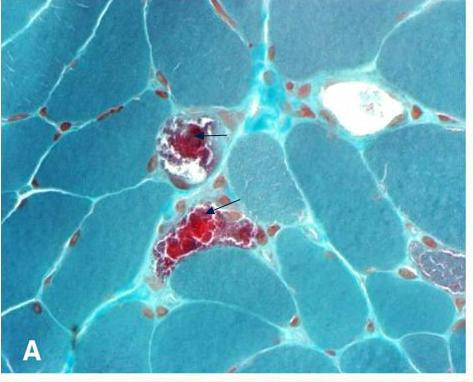|
Mitochondrial Myopathy
Mitochondrial myopathies are types of myopathies associated with mitochondrial disease. On biopsy, the muscle tissue of patients with these diseases usually demonstrate "ragged red" muscle fibers. These ragged-red fibers contain mild accumulations of glycogen and neutral lipids, and may show an increased reactivity for succinate dehydrogenase and a decreased reactivity for cytochrome c oxidase. Inheritance was believed to be maternal ( non-Mendelian extranuclear). It is now known that certain nuclear DNA deletions can also cause mitochondrial myopathy such as the OPA1 gene deletion. There are several subcategories of mitochondrial myopathies. Signs and symptoms Signs and symptoms include (for each of the following causes): * Mitochondrial encephalomyopathy, lactic acidosis, and stroke-like syndrome (MELAS) ** Varying degrees of cognitive impairment and dementia ** Lactic acidosis ** Strokes ** Transient ischemic attacks ** Hearing loss ** Weight loss * Myoclonic epilepsy and ra ... [...More Info...] [...Related Items...] OR: [Wikipedia] [Google] [Baidu] |
Myopathy
In medicine, myopathy is a disease of the muscle in which the muscle fibers do not function properly. This results in muscular weakness. ''Myopathy'' means muscle disease (Greek : myo- ''muscle'' + patheia '' -pathy'' : ''suffering''). This meaning implies that the primary defect is within the muscle, as opposed to the nerves ("neuropathies" or "neurogenic" disorders) or elsewhere (e.g., the brain). Muscle cramps, stiffness, and spasm can also be associated with myopathy. Capture myopathy can occur in wild or captive animals, such as deer and kangaroos, and leads to morbidity and mortality. It usually occurs as a result of stress and physical exertion during capture and restraint. Muscular disease can be classified as neuromuscular or musculoskeletal in nature. Some conditions, such as myositis, can be considered both neuromuscular and musculoskeletal. Signs and symptoms Common symptoms include muscle weakness, cramps, stiffness, and tetany. Systemic diseases Myopathies i ... [...More Info...] [...Related Items...] OR: [Wikipedia] [Google] [Baidu] |
Kearns–Sayre Syndrome
Kearns–Sayre syndrome (KSS), oculocraniosomatic disorder or oculocranionsomatic neuromuscular disorder with ragged red fibers is a mitochondrial myopathy with a typical onset before 20 years of age. KSS is a more severe syndromic variant of chronic progressive external ophthalmoplegia (abbreviated CPEO), a syndrome that is characterized by isolated involvement of the muscles controlling movement of the eyelid (levator palpebrae, orbicularis oculi) and eye (extra-ocular muscles). This results in ptosis and ophthalmoplegia respectively. KSS involves a combination of the already described CPEO as well as pigmentary retinopathy in both eyes and cardiac conduction abnormalities. Other symptoms may include cerebellar ataxia, proximal muscle weakness, deafness, diabetes mellitus, growth hormone deficiency, hypoparathyroidism, and other endocrinopathies. In both of these diseases, muscle involvement may begin unilaterally but always develops into a bilateral deficit, and the course is pr ... [...More Info...] [...Related Items...] OR: [Wikipedia] [Google] [Baidu] |
Metabolic Myopathy
Metabolic myopathies are Myopathy, myopathies that result from defects in biochemical metabolism that primarily affect muscle. They are generally genetic defects that interfere with muscle's ability to create energy. At the cellular level, metabolic myopathies lack some kind of enzyme that prevent the chemical reactions necessary to create Adenosine triphosphate, adenosine triphosphate (ATP). ATP is often referred to as the "molecular unit of currency" of intracellular energy transfer. The lack of ATP prevents the muscle cells from being able to function properly. Some people with a metabolic myopathy never develop symptoms due to the body's ability to produce enough ATP through alternative pathways. ATP → ADP + Pi + energy → muscle contraction ATP is needed for muscle contraction by two processes: # Firstly, ATP is needed for transport proteins to actively transport Calcium metabolism#Muscle, calcium ions into the sarcoplasmic reticulum (SR) of the muscle cell between musc ... [...More Info...] [...Related Items...] OR: [Wikipedia] [Google] [Baidu] |
Protofection
Protofection is a protein-mediated transfection of foreign mitochondrial DNA (mtDNA) into the mitochondria of cells in a tissue to supplement or replace the native mitochondrial DNA already present. The complete mtDNA genome or just fragments of mtDNA generated by polymerase chain reaction can be transferred into the target mitochondria through the technique. Scientists have hypothesized for the last couple of decades that protofection can be beneficial for patients with mitochondrial diseases. This technique is a recent development and is continuously being improved. As mitochondrial DNA becomes progressively more damaged with age, this may provide a method of at least partially rejuvenating mitochondria in old tissue, restoring them to their original, youthful function. Method Protofection is a developing technique and is continuously being improved. A specific protein transduction system has been created that is complexed with mtDNA, which enables the mtDNA to move across ... [...More Info...] [...Related Items...] OR: [Wikipedia] [Google] [Baidu] |
Hereditary Disease
A genetic disorder is a health problem caused by one or more abnormalities in the genome. It can be caused by a mutation in a single gene (monogenic) or multiple genes (polygenic) or by a chromosomal abnormality. Although polygenic disorders are the most common, the term is mostly used when discussing disorders with a single genetic cause, either in a gene or chromosome. The mutation responsible can occur spontaneously before embryonic development (a ''de novo'' mutation), or it can be inherited from two parents who are carriers of a faulty gene (autosomal recessive inheritance) or from a parent with the disorder (autosomal dominant inheritance). When the genetic disorder is inherited from one or both parents, it is also classified as a hereditary disease. Some disorders are caused by a mutation on the X chromosome and have X-linked inheritance. Very few disorders are inherited on the Y chromosome or mitochondrial DNA (due to their size). There are well over 6,000 known genet ... [...More Info...] [...Related Items...] OR: [Wikipedia] [Google] [Baidu] |
Ophthalmoparesis
Ophthalmoparesis refers to weakness (-paresis) or paralysis (-plegia) of one or more extraocular muscles which are responsible for eye movements. It is a physical finding in certain neurologic, ophthalmologic, and endocrine disease. Internal ophthalmoplegia means involvement limited to the pupillary sphincter and ciliary muscle. External ophthalmoplegia refers to involvement of only the extraocular muscles. Complete ophthalmoplegia indicates involvement of both. Causes Ophthalmoparesis can result from disorders of various parts of the eye and nervous system: * Infection around the eye. Ophthalmoplegia is an important finding in orbital cellulitis. * The orbit of the eye, including mechanical restrictions of eye movement, as in Graves' disease. * The muscle, as in progressive external ophthalmoplegia or Kearns–Sayre syndrome. * The neuromuscular junction, as in myasthenia gravis. * The relevant cranial nerves (specifically the oculomotor, trochlear, and abducens), as in caver ... [...More Info...] [...Related Items...] OR: [Wikipedia] [Google] [Baidu] |
Chronic Progressive External Ophthalmoplegia
Chronic progressive external ophthalmoplegia (CPEO) is a type of eye disorder characterized by slowly progressive inability to move the eyes and eyebrows. It is often the only feature of mitochondrial disease, in which case the term CPEO may be given as the diagnosis. In other people suffering from mitochondrial disease, CPEO occurs as part of a syndrome involving more than one part of the body, such as Kearns–Sayre syndrome. Occasionally CPEO may be caused by conditions other than mitochondrial diseases. Signs and symptoms CPEO is a rare disease that may affect those of all ages, but typically manifests in the young adult years. CPEO is the most common manifestation of mitochondrial myopathy, occurring in an estimated two-thirds of all cases of mitochondrial myopathy. Patients typically present with ptosis (drooping eyelids). Other diseases like Graves' disease, myasthenia gravis and glioma that may cause an external ophthalmoplegia must be ruled out. CPEO itself CPEO is ... [...More Info...] [...Related Items...] OR: [Wikipedia] [Google] [Baidu] |
Sensorineural Hearing Loss
Sensorineural hearing loss (SNHL) is a type of hearing loss in which the root cause lies in the inner ear or sensory organ (cochlea and associated structures) or the vestibulocochlear nerve (cranial nerve VIII). SNHL accounts for about 90% of reported hearing loss . SNHL is usually permanent and can be mild, moderate, severe, profound, or total. Various other descriptors can be used depending on the shape of the audiogram, such as high frequency, low frequency, U-shaped, notched, peaked, or flat. ''Sensory'' hearing loss often occurs as a consequence of damaged or deficient cochlear hair cells. Hair cells may be abnormal at birth or damaged during the lifetime of an individual. There are both external causes of damage, including infection, and ototoxic drugs, as well as intrinsic causes, including genetic mutations. A common cause or exacerbating factor in SNHL is prolonged exposure to environmental noise, or noise-induced hearing loss. Exposure to a single very loud noise such as ... [...More Info...] [...Related Items...] OR: [Wikipedia] [Google] [Baidu] |
Ophthalmoplegia
Ophthalmoparesis refers to weakness (-paresis) or paralysis (-plegia) of one or more extraocular muscles which are responsible for eye movements. It is a physical finding in certain neurologic, ophthalmologic, and endocrine disease. Internal ophthalmoplegia means involvement limited to the pupillary sphincter and ciliary muscle. External ophthalmoplegia refers to involvement of only the extraocular muscles. Complete ophthalmoplegia indicates involvement of both. Causes Ophthalmoparesis can result from disorders of various parts of the eye and nervous system: * Infection around the eye. Ophthalmoplegia is an important finding in orbital cellulitis. * The orbit of the eye, including mechanical restrictions of eye movement, as in Graves' disease. * The muscle, as in progressive external ophthalmoplegia or Kearns–Sayre syndrome. * The neuromuscular junction, as in myasthenia gravis. * The relevant cranial nerves (specifically the oculomotor, trochlear, and abducens), as in ca ... [...More Info...] [...Related Items...] OR: [Wikipedia] [Google] [Baidu] |
Gömöri Trichrome Stain
Gömöri trichrome stain is a histological stain used on muscle tissue. It can be used to test for certain forms of mitochondrial myopathy. It is named for George Gömöri George Gomori may refer to: * György Gömöri (1904–1957), Hungarian-American physician and histochemist * George Gomori (born 1934), Hungarian-born poet, writer and academic {{hndis, Gomori, George ..., who developed it in 1950.GOMORI, G. - A rapid one-step trichrome stain. Am. J. Clin. Path. 20: 661-664, 1950. References External links Staining 1950 introductions {{pathology-stub ... [...More Info...] [...Related Items...] OR: [Wikipedia] [Google] [Baidu] |
Mitochondrial Disease
Mitochondrial disease is a group of disorders caused by mitochondrial dysfunction. Mitochondria are the organelles that generate energy for the cell and are found in every cell of the human body except red blood cells. They convert the energy of food molecules into the ATP that powers most cell functions. Mitochondrial diseases take on unique characteristics both because of the way the diseases are often inherited and because mitochondria are so critical to cell function. A subclass of these diseases that have neuromuscular symptoms are known as mitochondrial myopathies. Types Examples of mitochondrial diseases include: * Mitochondrial myopathy * Diabetes mellitus and deafness (DAD) ** this combination at an early age can be due to mitochondrial disease ** Diabetes mellitus and deafness can be found together for other reasons * Leber's hereditary optic neuropathy (LHON) ** visual loss beginning in young adulthood ** eye disorder characterized by progressive loss of central v ... [...More Info...] [...Related Items...] OR: [Wikipedia] [Google] [Baidu] |




